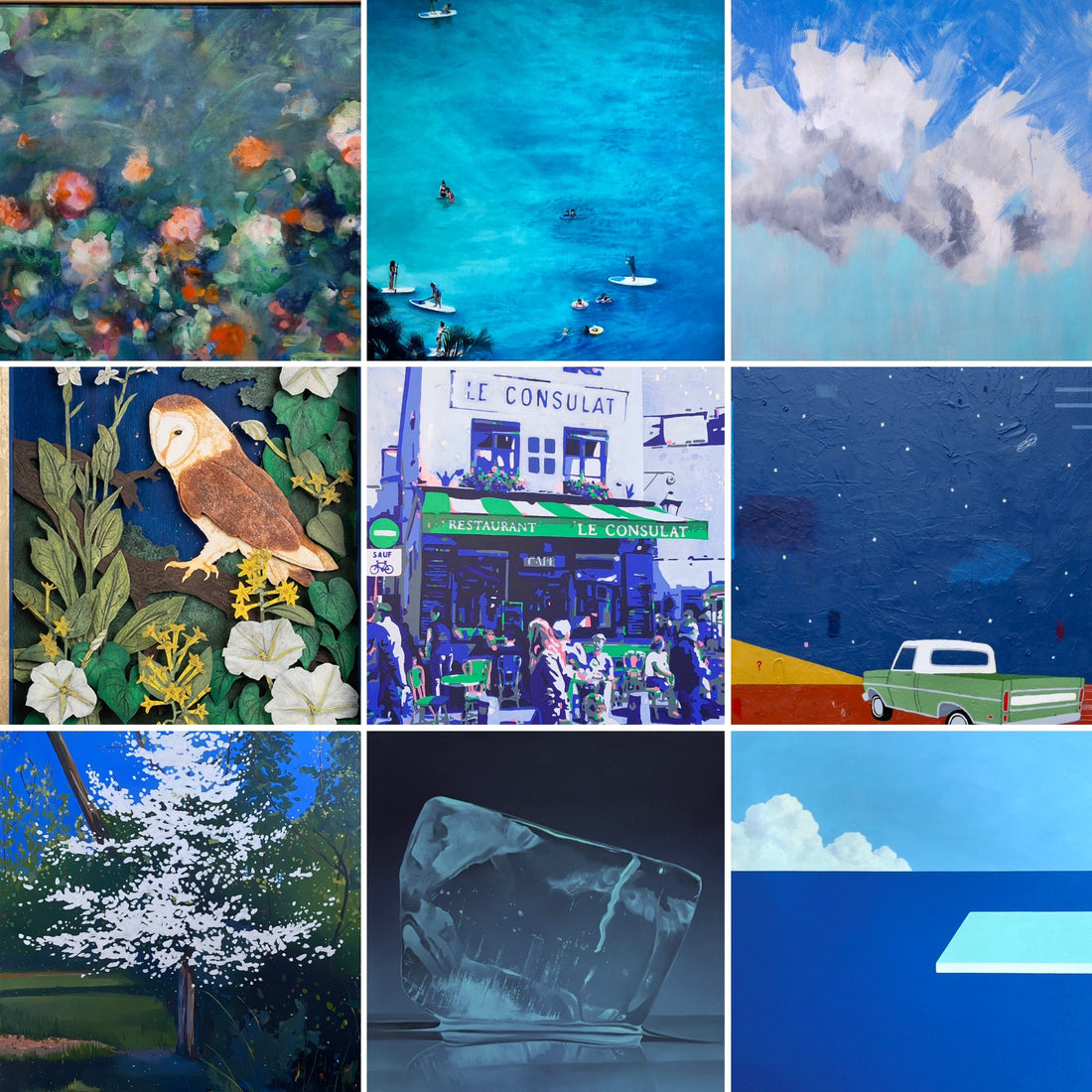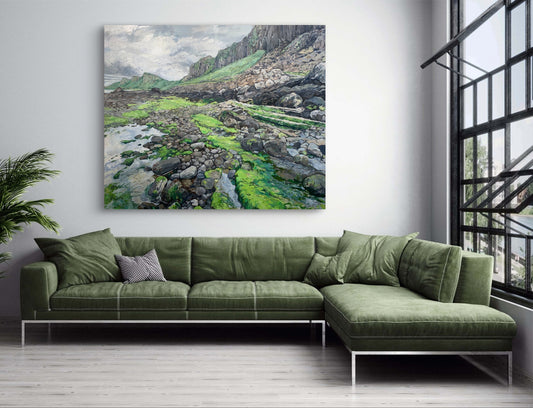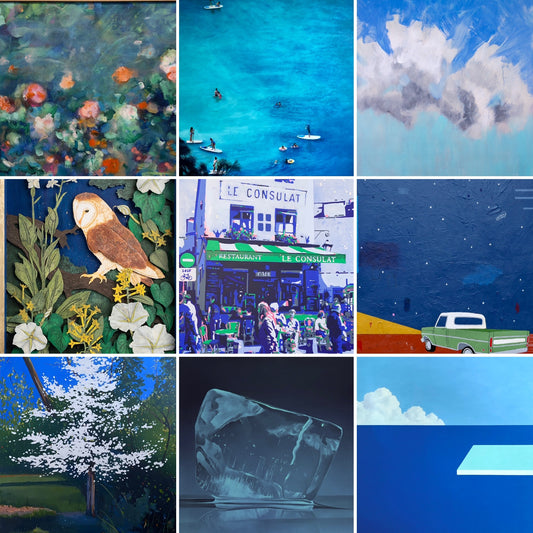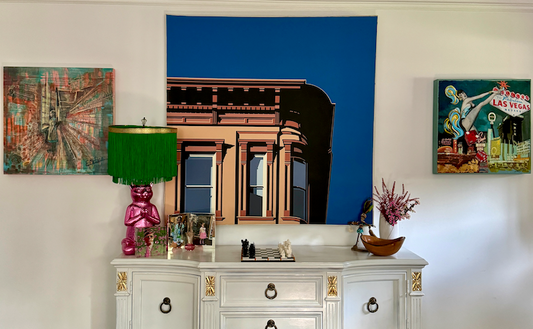I think all art is about connection. It connects us to our own emotions and can even bring us closer to those around us. Art makes connections that are unexpected, sometimes bringing seemingly unrelated things together. Many therapists, teachers, students, and hobbyists use art for just that. It helps us see the world differently. Scientists have even shown us that art is great for the brain. And, for those of us trying to introduce some self-care in our lives, art can be overlooked as something that is deeply healing.
Just simply contemplating a painting in my own house when I’m all alone, or creating a piece of my own art can be a transformative experience.
Unlocking the Emotional Power of Art
An artist’s job is to express the unseen - often without words. Bringing those ideas and emotions to light can often evoke a response to the viewer, connecting us to our deepest feelings.
Take, for example, the work of Ralston Fox Smith, whose geometric abstracts are quite soothing. “Constant” sits behind my desk at Spoonbill. I see it everyday and I love looking at the straight lines with very faint pencil lines below the paint. A feeling of admiration hits me because Fox does not use tape to create those. The four shades of green dance methodically across the canvas, and I think of all the different shades of green that I see when looking out the window at the trees. The simple line work takes my brain on a calm journey of quiet contemplation of nature, and I find peace. It definitely is not a bad way to start a morning off.
Explore art by Ralston Fox Smith →

Constant by Ralston Fox Smith
Personally, I remember the first time I stood before Claude Monet’s Water Lilies series. It was a collection in a small house in Phoenix, Arizona. At that point in time I had only ever seen prints. So when I got up close and saw exactly how much paint was on that canvas, I was blown away. I could feel how much love and respect he had for nature and its raw beauty. This experience was a powerful reminder of how art can touch our hearts and offer comfort when words fall short.
Art as a Tool for Wellness
Art makes us feel good. It really is true. Girija Kaimal is a professor at Drexel University and a researcher in art therapy. She discovered that “engaging in any sort of visual expression results in the reward pathway in the brain being activated." Interacting with art, whether through creation or observation, can significantly reduce stress, enhance mindfulness, and improve overall mental health. Did you know that the average person spends 8 seconds looking at a piece of art while in a gallery or museum? Just spending a little bit more time with a piece of work will help mental wellbeing. A fantastic read about this subject and the New York gallery world is “Get the Picture” by Bianca Bosker. It is a great journey about why art matters and how to engage with it more deeply.
Other research supports the positive effects of art on mental health. Studies have found that even brief periods of creative activity can lower cortisol levels (a marker of stress) and increase feelings of relaxation. Moreover, the act of creating art allows for self-expression and self-discovery, helping individuals process emotions and experiences in a non-verbal way.
Incorporating art into your daily routine doesn’t have to be complicated. Start with mindful observation: take a few minutes each day to focus on a piece of art, whether it’s a painting, a photograph, or even a pattern on your coffee cup. Notice the colors, shapes, and how it makes you feel. You can also try art journaling, where you express your thoughts and emotions through sketches or doodles. If you’re feeling adventurous, pick up a brush and create your own art—remember, it’s about the process, not the product.
If you struggle with where to start. My daughter and I love “Create this Book” by Moriah Elizabeth. She has inspiring prompts to get creative juices flowing. We use this on rainy days or just when I want to create something quickly to give myself a moment to focus on something specific.
How Does Art Help Mental and Emotional Health?
Art's positive impact on our well-being goes beyond simply providing enjoyment. It can actively improve our mental and emotional health in a number of ways:
- Reduces stress and anxiety: Engaging in creative activities has been shown to lower cortisol levels, the stress hormone. The act of focusing on the artistic process can help quiet racing thoughts and provide a sense of calm.
- Boosts mood and combats depression: Art can evoke positive emotions and provide a sense of accomplishment, leading to improved mood and a greater sense of well-being. Creative expression can also offer an outlet for processing difficult emotions and experiences.
- Enhances self-awareness and self-esteem: Creating art can be a journey of self-discovery, helping individuals explore their identity, express their feelings, and develop a deeper understanding of themselves. This can lead to increased self-esteem and confidence.
- Promotes mindfulness and relaxation: The focus required for artistic activities can induce a state of mindfulness, bringing attention to the present moment and fostering a sense of relaxation.
- Encourages emotional expression: Art offers a non-verbal way to communicate and process complex emotions, providing a safe and cathartic outlet for those who may struggle with verbal expression.
- Fosters a sense of connection: Participating in art-related activities or simply appreciating art can create a sense of community and connection with others.
Building Your Artful Sanctuary
Your home is your sanctuary, and art can play a crucial role in creating a space that nurtures your emotional and mental wellbeing. The right pieces of art can transform your living environment into a haven of relaxation, inspiration, and energy.
When selecting art for your home, think about the emotional atmosphere you want to create. For relaxation, choose art with soft, muted colors and serene imagery. For example, Amelia G. DeHart’s abstract flowers. She creates complex yet soothing abstracts using vivid pigments and fluid-like shapes.

To boost focus, look for pieces that are visually stimulating but not overwhelming—abstract art with clean lines and balanced compositions can be particularly effective. To boost focus, take a look at Kate Schultz. Her work has a very balanced color pallet with clean lines.

Kate Schultz Art
For a burst of energy, opt for bold, vibrant art that makes a statement. For that burst of energy, look at Moni Hill’s paintings. Her work is filled with joy, nature, and pops of color. All of our favorite things!

Painting by Moni Hill
Consider the color blue. 10% of the people around the world love the color blue. When Rachel and I started to hang the art for the first time on the gallery walls, we talked about how much blue was in all of our artist paintings. Blue represents intuition, inspiration, and inner peace. It seems to be a favorite among our artists, too. One tool you can use on our website is filtering by color to find your next piece of art.
Explore the full art collection at Spoonbill Gallery →

Don’t limit yourself to just paintings—explore various art forms like sculptures and mixed media. A carefully placed sculpture can add dimension and interest to a room, while a mixed-media piece can serve as a focal point that inspires conversation and reflection. Take for example, Bess Whittington’s mixed Media pieces.

Bess Whittington mixed media art
When choosing art that speaks to your emotions, consider what feelings you want to evoke. Do you seek peace and relaxation? Look for art with calming colors and gentle forms. Are you in need of inspiration? Opt for bold, dynamic pieces that stir your creative spirit. Allow your intuition to guide you in selecting art that resonates with your inner world.
Learn more: How to Curate Art For Your Home
Embrace the Healing Power of Art
The connection between art, emotions, and wellbeing is undeniable. Art has the power to touch our hearts, soothe our minds, and transform our spaces into sanctuaries of peace and inspiration. As you explore your own emotional connection to art, remember that it’s not just about what you see—it’s about what you feel.
I encourage you to take the time to discover art that resonates with you. Visit Spoonbill Gallery and explore our online collections, and immerse yourself in the world of creativity. And when you find a piece that speaks to you, bring it into your life and let it enrich your emotional and mental wellbeing.
Art is not just for the eyes—it’s for the soul. Share your art stories with us on social media, and let’s continue this journey of emotional exploration and connection together.
Plan your Spoonbill visit, see upcoming exhibits and events →
You might also like:




